The Decline of the High Street
VerifiedAdded on 2023/06/14
|13
|2931
|448
AI Summary
This report reflects upon the issues and challenges currently faced by high street. It identifies the nature, scope and impact of the problems that high street is currently facing. SWOT and PESTLE analysis are conducted in order to develop understanding on relevant strategies that could be adopted to cope with challenges.
Contribute Materials
Your contribution can guide someone’s learning journey. Share your
documents today.
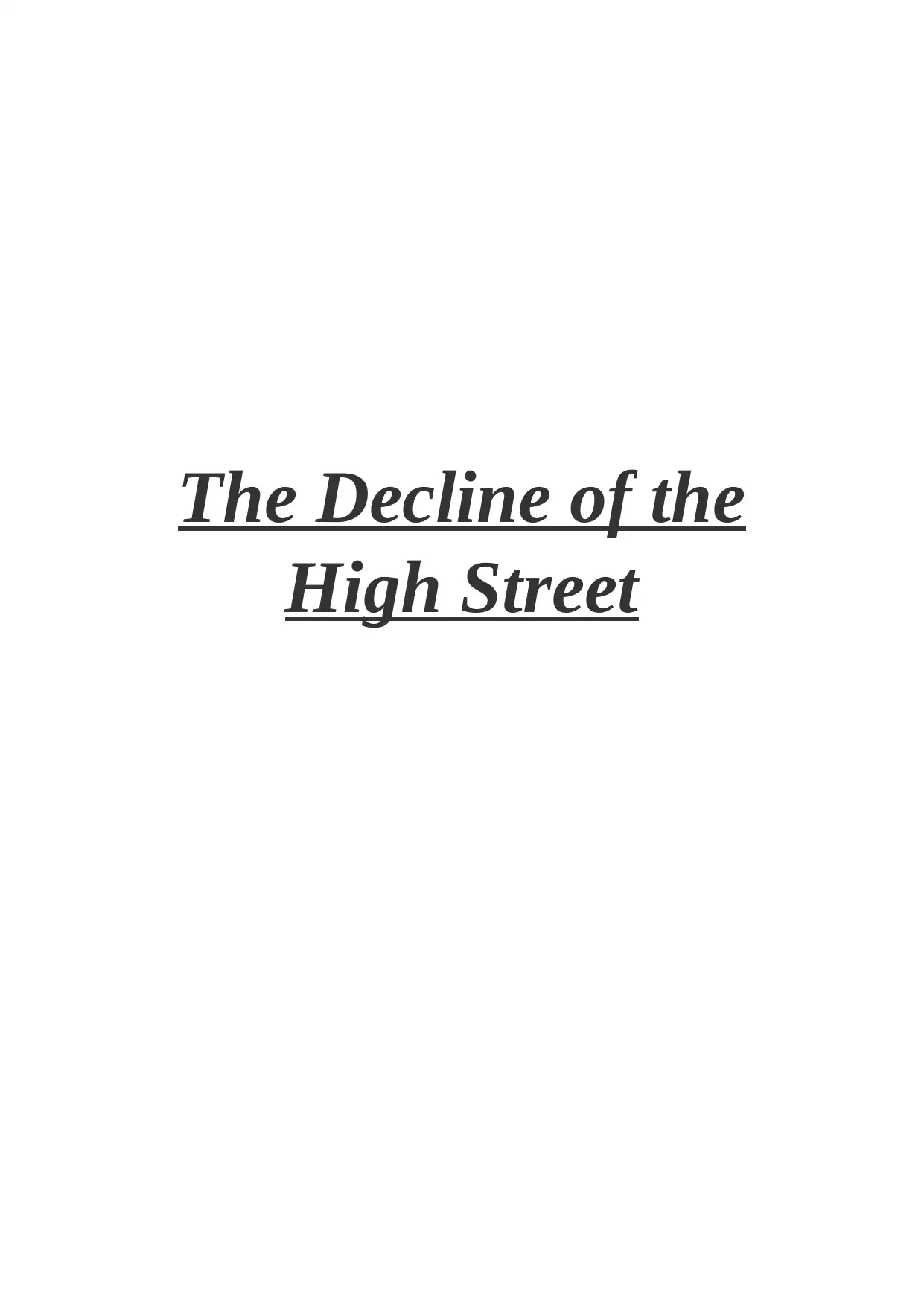
The Decline of the
High Street
High Street
Secure Best Marks with AI Grader
Need help grading? Try our AI Grader for instant feedback on your assignments.
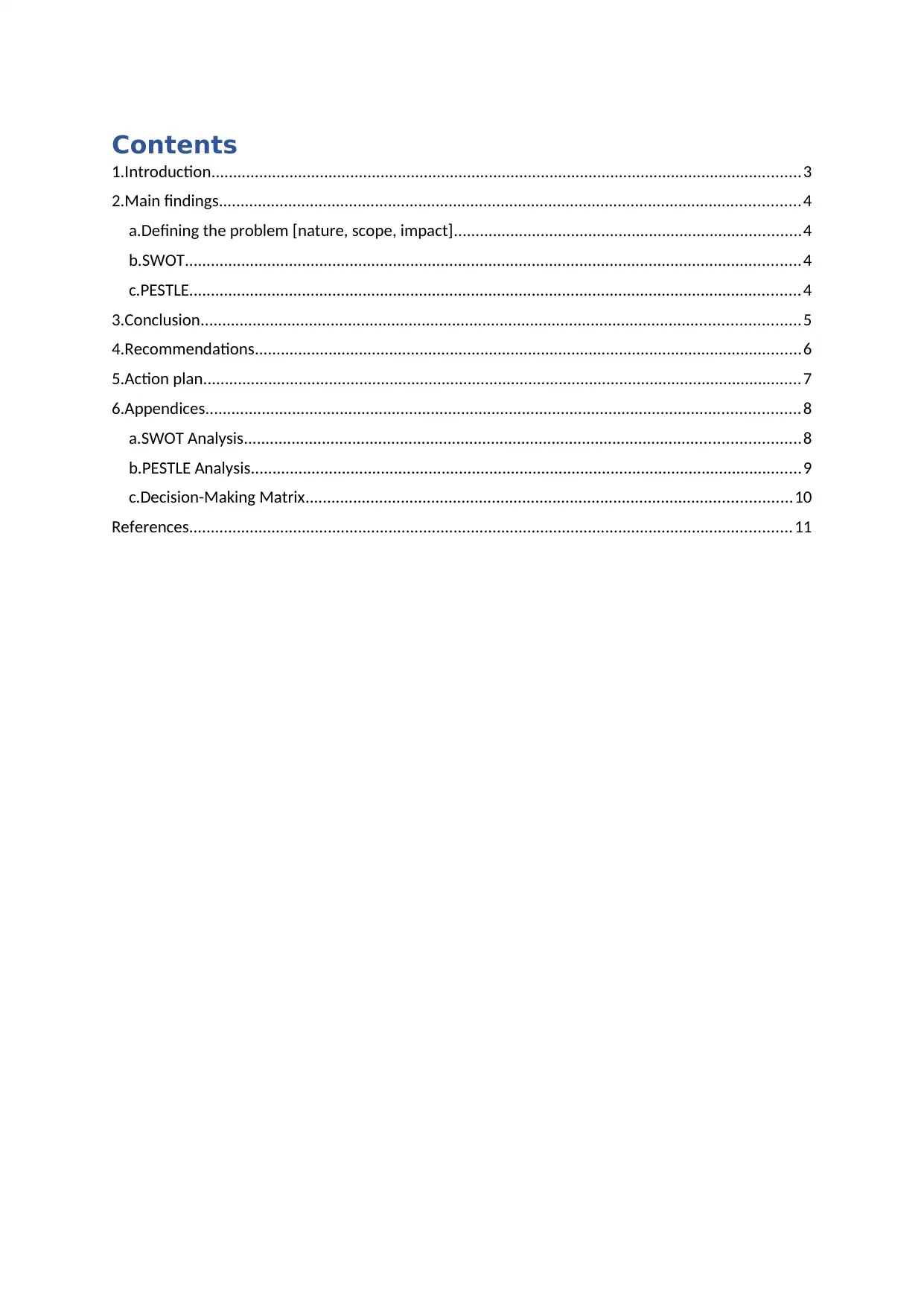
Contents
1.Introduction........................................................................................................................................3
2.Main findings......................................................................................................................................4
a.Defining the problem [nature, scope, impact]................................................................................4
b.SWOT..............................................................................................................................................4
c.PESTLE.............................................................................................................................................4
3.Conclusion..........................................................................................................................................5
4.Recommendations..............................................................................................................................6
5.Action plan..........................................................................................................................................7
6.Appendices.........................................................................................................................................8
a.SWOT Analysis................................................................................................................................8
b.PESTLE Analysis...............................................................................................................................9
c.Decision-Making Matrix................................................................................................................10
References...........................................................................................................................................11
1.Introduction........................................................................................................................................3
2.Main findings......................................................................................................................................4
a.Defining the problem [nature, scope, impact]................................................................................4
b.SWOT..............................................................................................................................................4
c.PESTLE.............................................................................................................................................4
3.Conclusion..........................................................................................................................................5
4.Recommendations..............................................................................................................................6
5.Action plan..........................................................................................................................................7
6.Appendices.........................................................................................................................................8
a.SWOT Analysis................................................................................................................................8
b.PESTLE Analysis...............................................................................................................................9
c.Decision-Making Matrix................................................................................................................10
References...........................................................................................................................................11
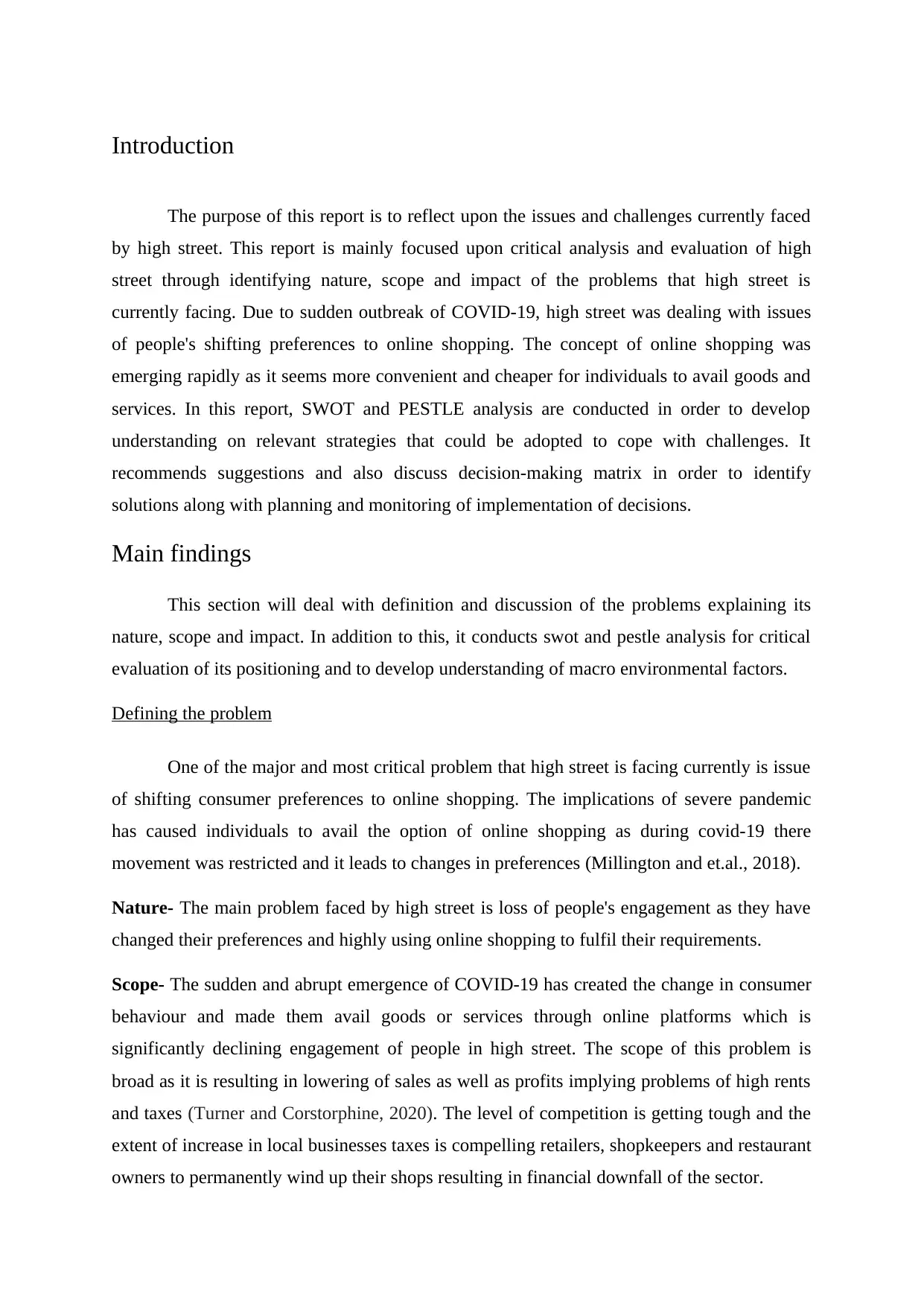
Introduction
The purpose of this report is to reflect upon the issues and challenges currently faced
by high street. This report is mainly focused upon critical analysis and evaluation of high
street through identifying nature, scope and impact of the problems that high street is
currently facing. Due to sudden outbreak of COVID-19, high street was dealing with issues
of people's shifting preferences to online shopping. The concept of online shopping was
emerging rapidly as it seems more convenient and cheaper for individuals to avail goods and
services. In this report, SWOT and PESTLE analysis are conducted in order to develop
understanding on relevant strategies that could be adopted to cope with challenges. It
recommends suggestions and also discuss decision-making matrix in order to identify
solutions along with planning and monitoring of implementation of decisions.
Main findings
This section will deal with definition and discussion of the problems explaining its
nature, scope and impact. In addition to this, it conducts swot and pestle analysis for critical
evaluation of its positioning and to develop understanding of macro environmental factors.
Defining the problem
One of the major and most critical problem that high street is facing currently is issue
of shifting consumer preferences to online shopping. The implications of severe pandemic
has caused individuals to avail the option of online shopping as during covid-19 there
movement was restricted and it leads to changes in preferences (Millington and et.al., 2018).
Nature- The main problem faced by high street is loss of people's engagement as they have
changed their preferences and highly using online shopping to fulfil their requirements.
Scope- The sudden and abrupt emergence of COVID-19 has created the change in consumer
behaviour and made them avail goods or services through online platforms which is
significantly declining engagement of people in high street. The scope of this problem is
broad as it is resulting in lowering of sales as well as profits implying problems of high rents
and taxes (Turner and Corstorphine, 2020). The level of competition is getting tough and the
extent of increase in local businesses taxes is compelling retailers, shopkeepers and restaurant
owners to permanently wind up their shops resulting in financial downfall of the sector.
The purpose of this report is to reflect upon the issues and challenges currently faced
by high street. This report is mainly focused upon critical analysis and evaluation of high
street through identifying nature, scope and impact of the problems that high street is
currently facing. Due to sudden outbreak of COVID-19, high street was dealing with issues
of people's shifting preferences to online shopping. The concept of online shopping was
emerging rapidly as it seems more convenient and cheaper for individuals to avail goods and
services. In this report, SWOT and PESTLE analysis are conducted in order to develop
understanding on relevant strategies that could be adopted to cope with challenges. It
recommends suggestions and also discuss decision-making matrix in order to identify
solutions along with planning and monitoring of implementation of decisions.
Main findings
This section will deal with definition and discussion of the problems explaining its
nature, scope and impact. In addition to this, it conducts swot and pestle analysis for critical
evaluation of its positioning and to develop understanding of macro environmental factors.
Defining the problem
One of the major and most critical problem that high street is facing currently is issue
of shifting consumer preferences to online shopping. The implications of severe pandemic
has caused individuals to avail the option of online shopping as during covid-19 there
movement was restricted and it leads to changes in preferences (Millington and et.al., 2018).
Nature- The main problem faced by high street is loss of people's engagement as they have
changed their preferences and highly using online shopping to fulfil their requirements.
Scope- The sudden and abrupt emergence of COVID-19 has created the change in consumer
behaviour and made them avail goods or services through online platforms which is
significantly declining engagement of people in high street. The scope of this problem is
broad as it is resulting in lowering of sales as well as profits implying problems of high rents
and taxes (Turner and Corstorphine, 2020). The level of competition is getting tough and the
extent of increase in local businesses taxes is compelling retailers, shopkeepers and restaurant
owners to permanently wind up their shops resulting in financial downfall of the sector.
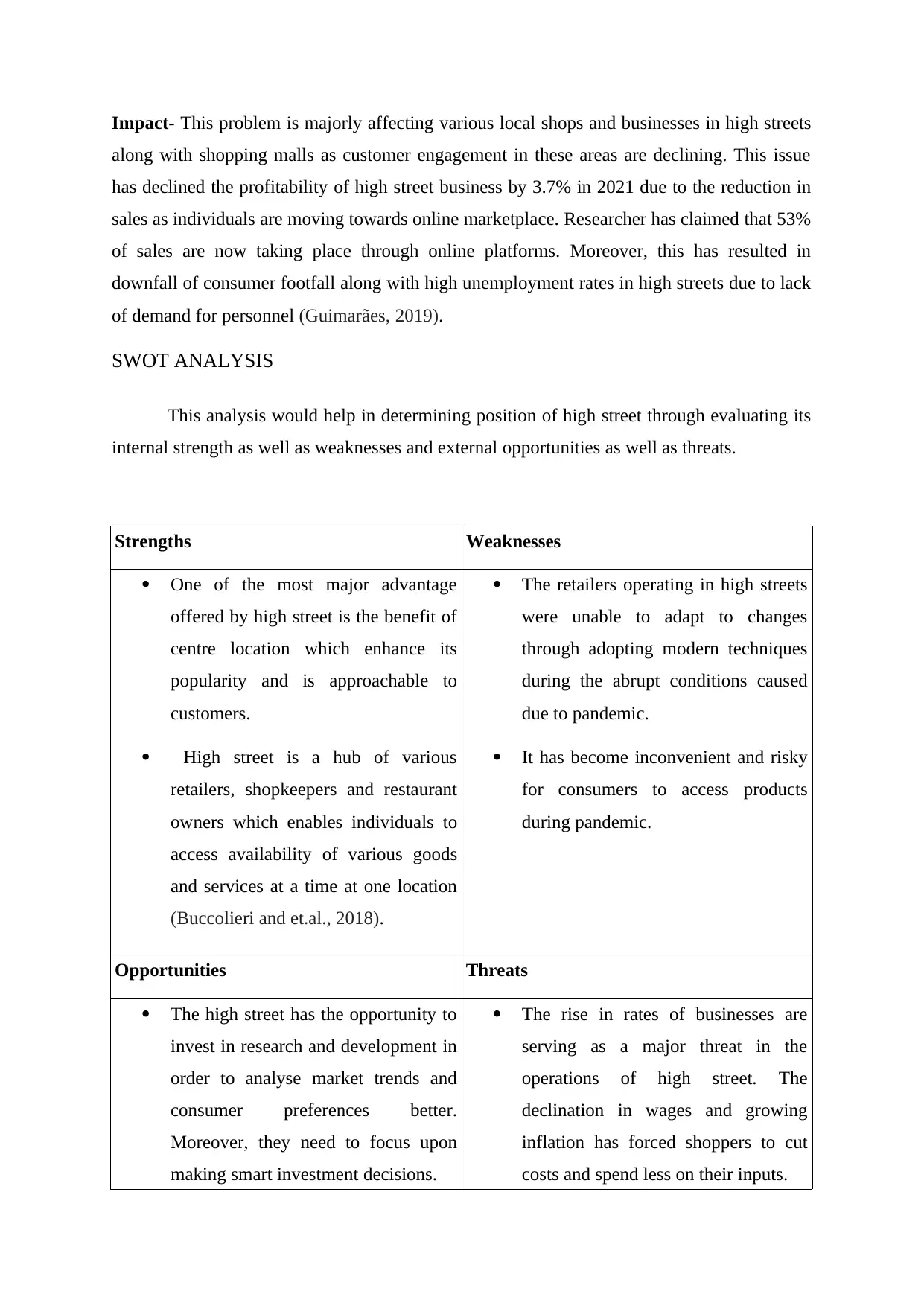
Impact- This problem is majorly affecting various local shops and businesses in high streets
along with shopping malls as customer engagement in these areas are declining. This issue
has declined the profitability of high street business by 3.7% in 2021 due to the reduction in
sales as individuals are moving towards online marketplace. Researcher has claimed that 53%
of sales are now taking place through online platforms. Moreover, this has resulted in
downfall of consumer footfall along with high unemployment rates in high streets due to lack
of demand for personnel (Guimarães, 2019).
SWOT ANALYSIS
This analysis would help in determining position of high street through evaluating its
internal strength as well as weaknesses and external opportunities as well as threats.
Strengths Weaknesses
One of the most major advantage
offered by high street is the benefit of
centre location which enhance its
popularity and is approachable to
customers.
High street is a hub of various
retailers, shopkeepers and restaurant
owners which enables individuals to
access availability of various goods
and services at a time at one location
(Buccolieri and et.al., 2018).
The retailers operating in high streets
were unable to adapt to changes
through adopting modern techniques
during the abrupt conditions caused
due to pandemic.
It has become inconvenient and risky
for consumers to access products
during pandemic.
Opportunities Threats
The high street has the opportunity to
invest in research and development in
order to analyse market trends and
consumer preferences better.
Moreover, they need to focus upon
making smart investment decisions.
The rise in rates of businesses are
serving as a major threat in the
operations of high street. The
declination in wages and growing
inflation has forced shoppers to cut
costs and spend less on their inputs.
along with shopping malls as customer engagement in these areas are declining. This issue
has declined the profitability of high street business by 3.7% in 2021 due to the reduction in
sales as individuals are moving towards online marketplace. Researcher has claimed that 53%
of sales are now taking place through online platforms. Moreover, this has resulted in
downfall of consumer footfall along with high unemployment rates in high streets due to lack
of demand for personnel (Guimarães, 2019).
SWOT ANALYSIS
This analysis would help in determining position of high street through evaluating its
internal strength as well as weaknesses and external opportunities as well as threats.
Strengths Weaknesses
One of the most major advantage
offered by high street is the benefit of
centre location which enhance its
popularity and is approachable to
customers.
High street is a hub of various
retailers, shopkeepers and restaurant
owners which enables individuals to
access availability of various goods
and services at a time at one location
(Buccolieri and et.al., 2018).
The retailers operating in high streets
were unable to adapt to changes
through adopting modern techniques
during the abrupt conditions caused
due to pandemic.
It has become inconvenient and risky
for consumers to access products
during pandemic.
Opportunities Threats
The high street has the opportunity to
invest in research and development in
order to analyse market trends and
consumer preferences better.
Moreover, they need to focus upon
making smart investment decisions.
The rise in rates of businesses are
serving as a major threat in the
operations of high street. The
declination in wages and growing
inflation has forced shoppers to cut
costs and spend less on their inputs.
Secure Best Marks with AI Grader
Need help grading? Try our AI Grader for instant feedback on your assignments.
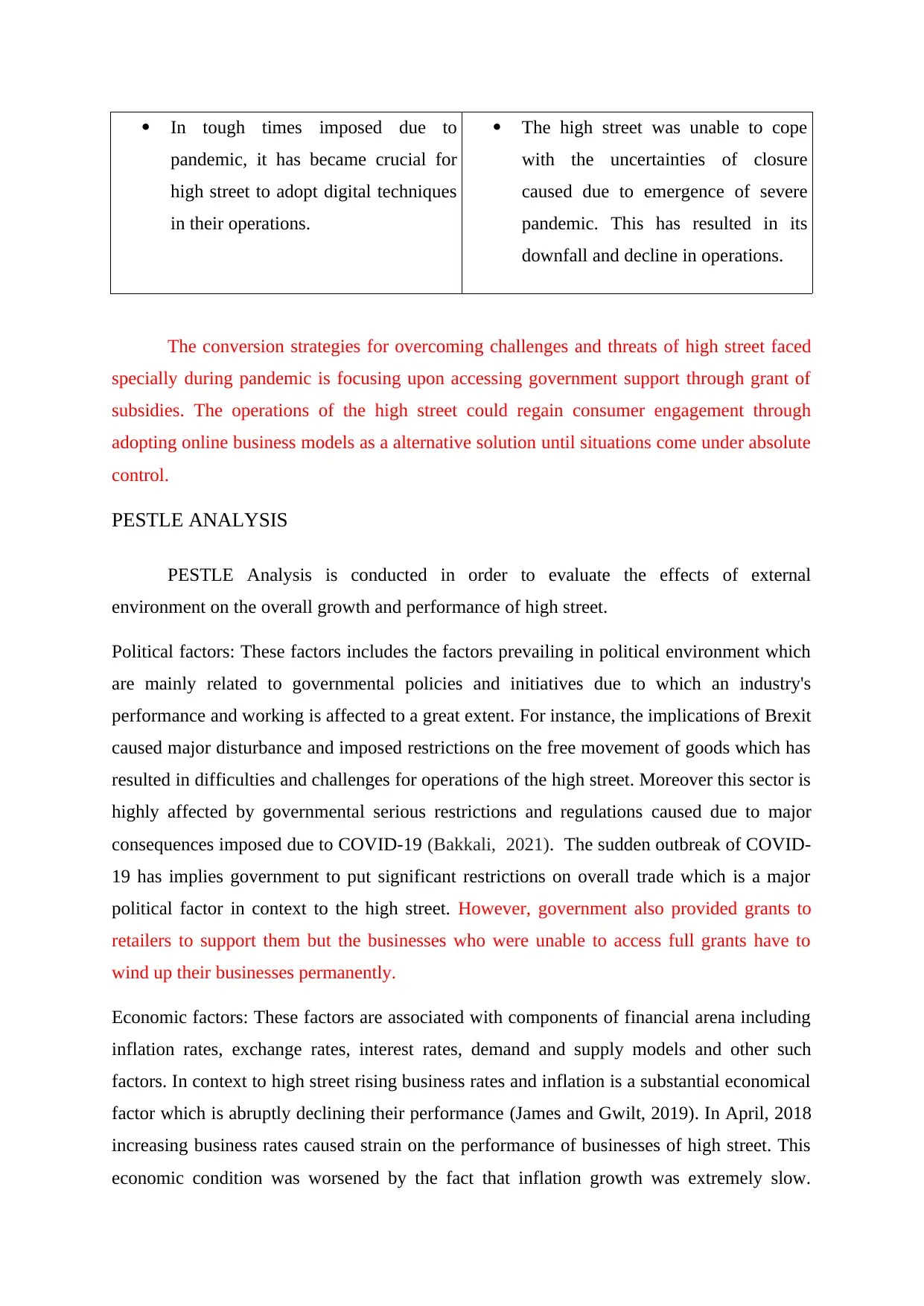
In tough times imposed due to
pandemic, it has became crucial for
high street to adopt digital techniques
in their operations.
The high street was unable to cope
with the uncertainties of closure
caused due to emergence of severe
pandemic. This has resulted in its
downfall and decline in operations.
The conversion strategies for overcoming challenges and threats of high street faced
specially during pandemic is focusing upon accessing government support through grant of
subsidies. The operations of the high street could regain consumer engagement through
adopting online business models as a alternative solution until situations come under absolute
control.
PESTLE ANALYSIS
PESTLE Analysis is conducted in order to evaluate the effects of external
environment on the overall growth and performance of high street.
Political factors: These factors includes the factors prevailing in political environment which
are mainly related to governmental policies and initiatives due to which an industry's
performance and working is affected to a great extent. For instance, the implications of Brexit
caused major disturbance and imposed restrictions on the free movement of goods which has
resulted in difficulties and challenges for operations of the high street. Moreover this sector is
highly affected by governmental serious restrictions and regulations caused due to major
consequences imposed due to COVID-19 (Bakkali, 2021). The sudden outbreak of COVID-
19 has implies government to put significant restrictions on overall trade which is a major
political factor in context to the high street. However, government also provided grants to
retailers to support them but the businesses who were unable to access full grants have to
wind up their businesses permanently.
Economic factors: These factors are associated with components of financial arena including
inflation rates, exchange rates, interest rates, demand and supply models and other such
factors. In context to high street rising business rates and inflation is a substantial economical
factor which is abruptly declining their performance (James and Gwilt, 2019). In April, 2018
increasing business rates caused strain on the performance of businesses of high street. This
economic condition was worsened by the fact that inflation growth was extremely slow.
pandemic, it has became crucial for
high street to adopt digital techniques
in their operations.
The high street was unable to cope
with the uncertainties of closure
caused due to emergence of severe
pandemic. This has resulted in its
downfall and decline in operations.
The conversion strategies for overcoming challenges and threats of high street faced
specially during pandemic is focusing upon accessing government support through grant of
subsidies. The operations of the high street could regain consumer engagement through
adopting online business models as a alternative solution until situations come under absolute
control.
PESTLE ANALYSIS
PESTLE Analysis is conducted in order to evaluate the effects of external
environment on the overall growth and performance of high street.
Political factors: These factors includes the factors prevailing in political environment which
are mainly related to governmental policies and initiatives due to which an industry's
performance and working is affected to a great extent. For instance, the implications of Brexit
caused major disturbance and imposed restrictions on the free movement of goods which has
resulted in difficulties and challenges for operations of the high street. Moreover this sector is
highly affected by governmental serious restrictions and regulations caused due to major
consequences imposed due to COVID-19 (Bakkali, 2021). The sudden outbreak of COVID-
19 has implies government to put significant restrictions on overall trade which is a major
political factor in context to the high street. However, government also provided grants to
retailers to support them but the businesses who were unable to access full grants have to
wind up their businesses permanently.
Economic factors: These factors are associated with components of financial arena including
inflation rates, exchange rates, interest rates, demand and supply models and other such
factors. In context to high street rising business rates and inflation is a substantial economical
factor which is abruptly declining their performance (James and Gwilt, 2019). In April, 2018
increasing business rates caused strain on the performance of businesses of high street. This
economic condition was worsened by the fact that inflation growth was extremely slow.
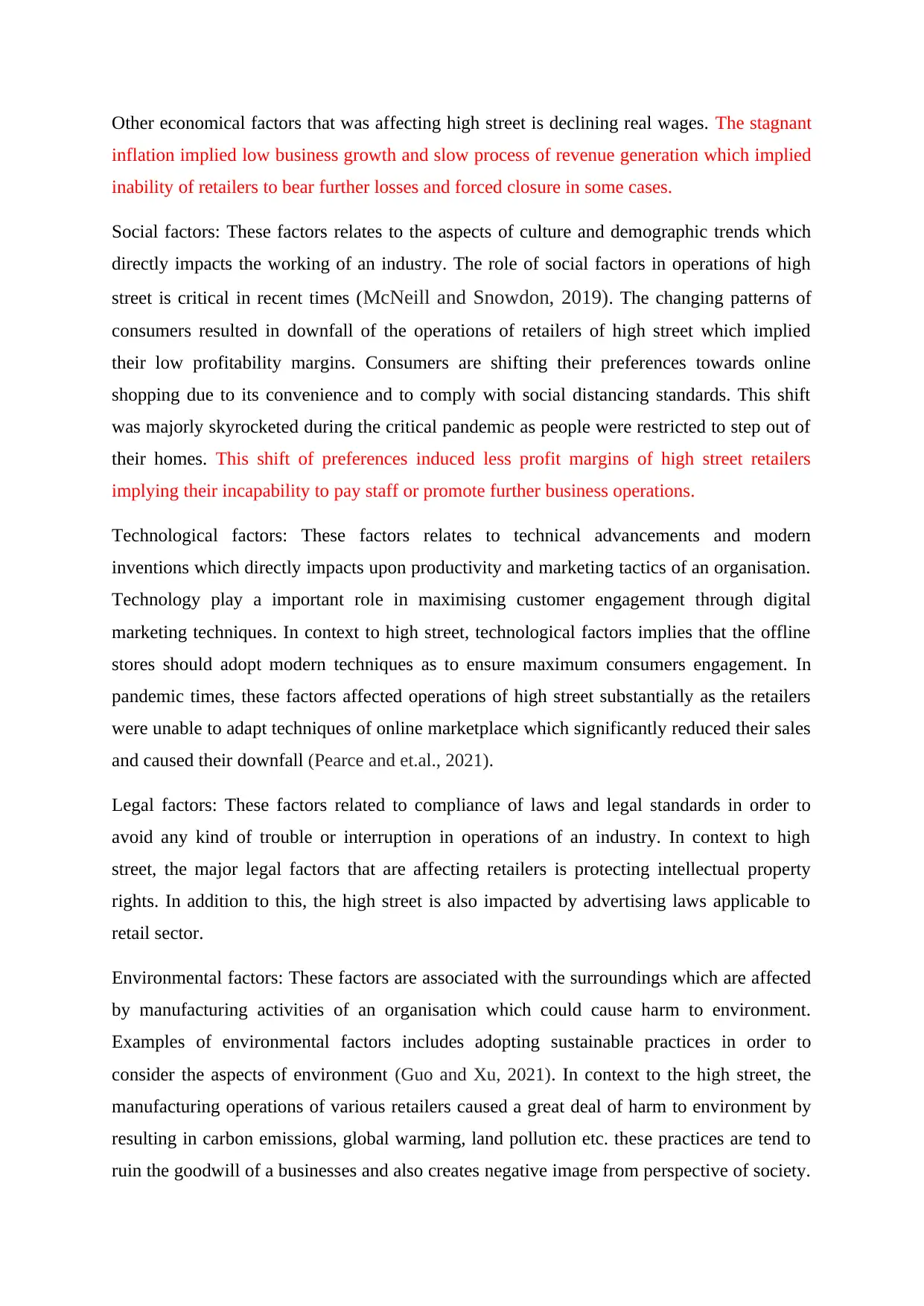
Other economical factors that was affecting high street is declining real wages. The stagnant
inflation implied low business growth and slow process of revenue generation which implied
inability of retailers to bear further losses and forced closure in some cases.
Social factors: These factors relates to the aspects of culture and demographic trends which
directly impacts the working of an industry. The role of social factors in operations of high
street is critical in recent times (McNeill and Snowdon, 2019). The changing patterns of
consumers resulted in downfall of the operations of retailers of high street which implied
their low profitability margins. Consumers are shifting their preferences towards online
shopping due to its convenience and to comply with social distancing standards. This shift
was majorly skyrocketed during the critical pandemic as people were restricted to step out of
their homes. This shift of preferences induced less profit margins of high street retailers
implying their incapability to pay staff or promote further business operations.
Technological factors: These factors relates to technical advancements and modern
inventions which directly impacts upon productivity and marketing tactics of an organisation.
Technology play a important role in maximising customer engagement through digital
marketing techniques. In context to high street, technological factors implies that the offline
stores should adopt modern techniques as to ensure maximum consumers engagement. In
pandemic times, these factors affected operations of high street substantially as the retailers
were unable to adapt techniques of online marketplace which significantly reduced their sales
and caused their downfall (Pearce and et.al., 2021).
Legal factors: These factors related to compliance of laws and legal standards in order to
avoid any kind of trouble or interruption in operations of an industry. In context to high
street, the major legal factors that are affecting retailers is protecting intellectual property
rights. In addition to this, the high street is also impacted by advertising laws applicable to
retail sector.
Environmental factors: These factors are associated with the surroundings which are affected
by manufacturing activities of an organisation which could cause harm to environment.
Examples of environmental factors includes adopting sustainable practices in order to
consider the aspects of environment (Guo and Xu, 2021). In context to the high street, the
manufacturing operations of various retailers caused a great deal of harm to environment by
resulting in carbon emissions, global warming, land pollution etc. these practices are tend to
ruin the goodwill of a businesses and also creates negative image from perspective of society.
inflation implied low business growth and slow process of revenue generation which implied
inability of retailers to bear further losses and forced closure in some cases.
Social factors: These factors relates to the aspects of culture and demographic trends which
directly impacts the working of an industry. The role of social factors in operations of high
street is critical in recent times (McNeill and Snowdon, 2019). The changing patterns of
consumers resulted in downfall of the operations of retailers of high street which implied
their low profitability margins. Consumers are shifting their preferences towards online
shopping due to its convenience and to comply with social distancing standards. This shift
was majorly skyrocketed during the critical pandemic as people were restricted to step out of
their homes. This shift of preferences induced less profit margins of high street retailers
implying their incapability to pay staff or promote further business operations.
Technological factors: These factors relates to technical advancements and modern
inventions which directly impacts upon productivity and marketing tactics of an organisation.
Technology play a important role in maximising customer engagement through digital
marketing techniques. In context to high street, technological factors implies that the offline
stores should adopt modern techniques as to ensure maximum consumers engagement. In
pandemic times, these factors affected operations of high street substantially as the retailers
were unable to adapt techniques of online marketplace which significantly reduced their sales
and caused their downfall (Pearce and et.al., 2021).
Legal factors: These factors related to compliance of laws and legal standards in order to
avoid any kind of trouble or interruption in operations of an industry. In context to high
street, the major legal factors that are affecting retailers is protecting intellectual property
rights. In addition to this, the high street is also impacted by advertising laws applicable to
retail sector.
Environmental factors: These factors are associated with the surroundings which are affected
by manufacturing activities of an organisation which could cause harm to environment.
Examples of environmental factors includes adopting sustainable practices in order to
consider the aspects of environment (Guo and Xu, 2021). In context to the high street, the
manufacturing operations of various retailers caused a great deal of harm to environment by
resulting in carbon emissions, global warming, land pollution etc. these practices are tend to
ruin the goodwill of a businesses and also creates negative image from perspective of society.
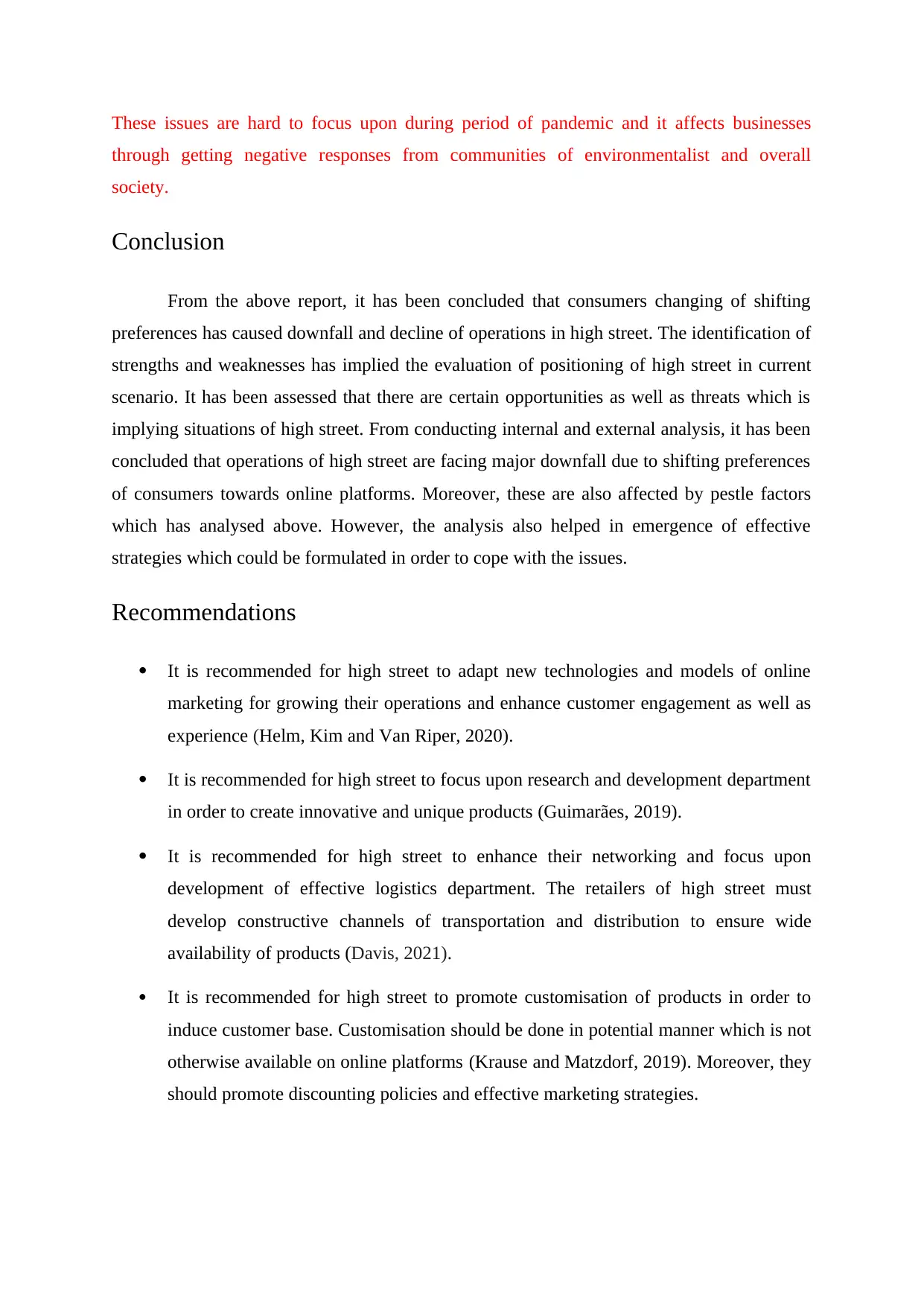
These issues are hard to focus upon during period of pandemic and it affects businesses
through getting negative responses from communities of environmentalist and overall
society.
Conclusion
From the above report, it has been concluded that consumers changing of shifting
preferences has caused downfall and decline of operations in high street. The identification of
strengths and weaknesses has implied the evaluation of positioning of high street in current
scenario. It has been assessed that there are certain opportunities as well as threats which is
implying situations of high street. From conducting internal and external analysis, it has been
concluded that operations of high street are facing major downfall due to shifting preferences
of consumers towards online platforms. Moreover, these are also affected by pestle factors
which has analysed above. However, the analysis also helped in emergence of effective
strategies which could be formulated in order to cope with the issues.
Recommendations
It is recommended for high street to adapt new technologies and models of online
marketing for growing their operations and enhance customer engagement as well as
experience (Helm, Kim and Van Riper, 2020).
It is recommended for high street to focus upon research and development department
in order to create innovative and unique products (Guimarães, 2019).
It is recommended for high street to enhance their networking and focus upon
development of effective logistics department. The retailers of high street must
develop constructive channels of transportation and distribution to ensure wide
availability of products (Davis, 2021).
It is recommended for high street to promote customisation of products in order to
induce customer base. Customisation should be done in potential manner which is not
otherwise available on online platforms (Krause and Matzdorf, 2019). Moreover, they
should promote discounting policies and effective marketing strategies.
through getting negative responses from communities of environmentalist and overall
society.
Conclusion
From the above report, it has been concluded that consumers changing of shifting
preferences has caused downfall and decline of operations in high street. The identification of
strengths and weaknesses has implied the evaluation of positioning of high street in current
scenario. It has been assessed that there are certain opportunities as well as threats which is
implying situations of high street. From conducting internal and external analysis, it has been
concluded that operations of high street are facing major downfall due to shifting preferences
of consumers towards online platforms. Moreover, these are also affected by pestle factors
which has analysed above. However, the analysis also helped in emergence of effective
strategies which could be formulated in order to cope with the issues.
Recommendations
It is recommended for high street to adapt new technologies and models of online
marketing for growing their operations and enhance customer engagement as well as
experience (Helm, Kim and Van Riper, 2020).
It is recommended for high street to focus upon research and development department
in order to create innovative and unique products (Guimarães, 2019).
It is recommended for high street to enhance their networking and focus upon
development of effective logistics department. The retailers of high street must
develop constructive channels of transportation and distribution to ensure wide
availability of products (Davis, 2021).
It is recommended for high street to promote customisation of products in order to
induce customer base. Customisation should be done in potential manner which is not
otherwise available on online platforms (Krause and Matzdorf, 2019). Moreover, they
should promote discounting policies and effective marketing strategies.
Paraphrase This Document
Need a fresh take? Get an instant paraphrase of this document with our AI Paraphraser
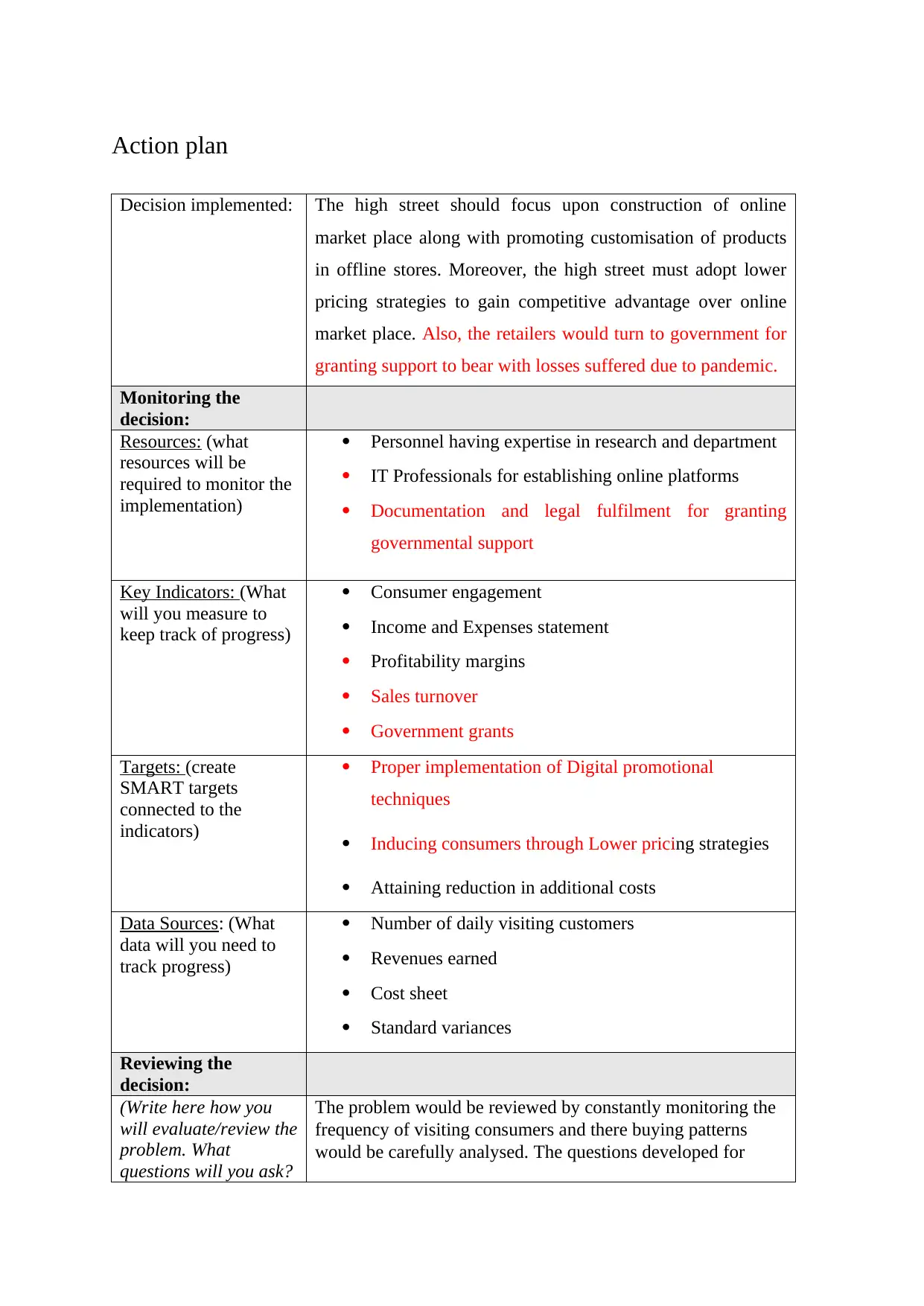
Action plan
Decision implemented: The high street should focus upon construction of online
market place along with promoting customisation of products
in offline stores. Moreover, the high street must adopt lower
pricing strategies to gain competitive advantage over online
market place. Also, the retailers would turn to government for
granting support to bear with losses suffered due to pandemic.
Monitoring the
decision:
Resources: (what
resources will be
required to monitor the
implementation)
Personnel having expertise in research and department
IT Professionals for establishing online platforms
Documentation and legal fulfilment for granting
governmental support
Key Indicators: (What
will you measure to
keep track of progress)
Consumer engagement
Income and Expenses statement
Profitability margins
Sales turnover
Government grants
Targets: (create
SMART targets
connected to the
indicators)
Proper implementation of Digital promotional
techniques
Inducing consumers through Lower pricing strategies
Attaining reduction in additional costs
Data Sources: (What
data will you need to
track progress)
Number of daily visiting customers
Revenues earned
Cost sheet
Standard variances
Reviewing the
decision:
(Write here how you
will evaluate/review the
problem. What
questions will you ask?
The problem would be reviewed by constantly monitoring the
frequency of visiting consumers and there buying patterns
would be carefully analysed. The questions developed for
Decision implemented: The high street should focus upon construction of online
market place along with promoting customisation of products
in offline stores. Moreover, the high street must adopt lower
pricing strategies to gain competitive advantage over online
market place. Also, the retailers would turn to government for
granting support to bear with losses suffered due to pandemic.
Monitoring the
decision:
Resources: (what
resources will be
required to monitor the
implementation)
Personnel having expertise in research and department
IT Professionals for establishing online platforms
Documentation and legal fulfilment for granting
governmental support
Key Indicators: (What
will you measure to
keep track of progress)
Consumer engagement
Income and Expenses statement
Profitability margins
Sales turnover
Government grants
Targets: (create
SMART targets
connected to the
indicators)
Proper implementation of Digital promotional
techniques
Inducing consumers through Lower pricing strategies
Attaining reduction in additional costs
Data Sources: (What
data will you need to
track progress)
Number of daily visiting customers
Revenues earned
Cost sheet
Standard variances
Reviewing the
decision:
(Write here how you
will evaluate/review the
problem. What
questions will you ask?
The problem would be reviewed by constantly monitoring the
frequency of visiting consumers and there buying patterns
would be carefully analysed. The questions developed for
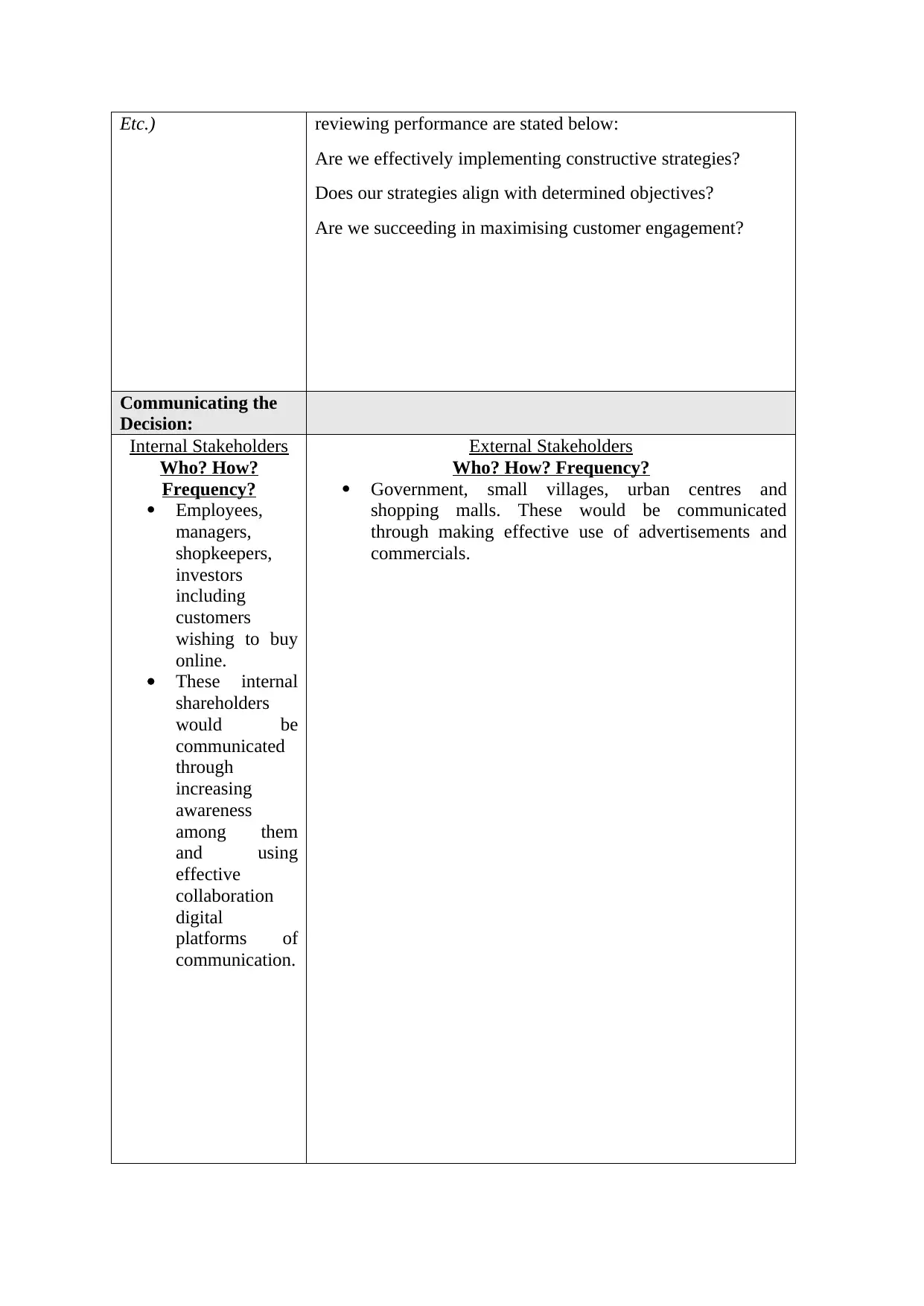
Etc.) reviewing performance are stated below:
Are we effectively implementing constructive strategies?
Does our strategies align with determined objectives?
Are we succeeding in maximising customer engagement?
Communicating the
Decision:
Internal Stakeholders
Who? How?
Frequency?
Employees,
managers,
shopkeepers,
investors
including
customers
wishing to buy
online.
These internal
shareholders
would be
communicated
through
increasing
awareness
among them
and using
effective
collaboration
digital
platforms of
communication.
External Stakeholders
Who? How? Frequency?
Government, small villages, urban centres and
shopping malls. These would be communicated
through making effective use of advertisements and
commercials.
Are we effectively implementing constructive strategies?
Does our strategies align with determined objectives?
Are we succeeding in maximising customer engagement?
Communicating the
Decision:
Internal Stakeholders
Who? How?
Frequency?
Employees,
managers,
shopkeepers,
investors
including
customers
wishing to buy
online.
These internal
shareholders
would be
communicated
through
increasing
awareness
among them
and using
effective
collaboration
digital
platforms of
communication.
External Stakeholders
Who? How? Frequency?
Government, small villages, urban centres and
shopping malls. These would be communicated
through making effective use of advertisements and
commercials.
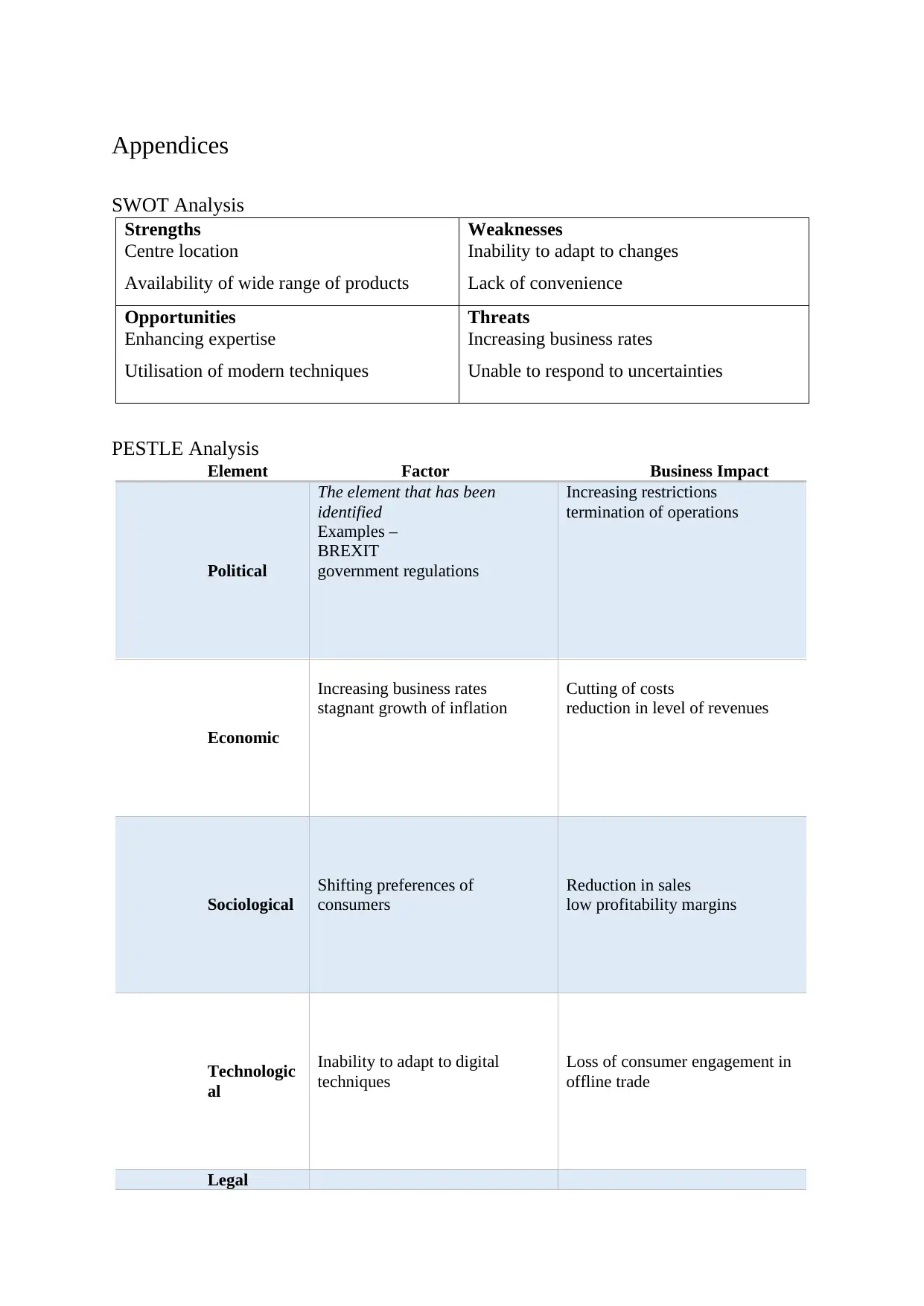
Appendices
SWOT Analysis
Strengths
Centre location
Availability of wide range of products
Weaknesses
Inability to adapt to changes
Lack of convenience
Opportunities
Enhancing expertise
Utilisation of modern techniques
Threats
Increasing business rates
Unable to respond to uncertainties
PESTLE Analysis
Element Factor Business Impact
Political
The element that has been
identified
Examples –
BREXIT
government regulations
Increasing restrictions
termination of operations
Economic
Increasing business rates
stagnant growth of inflation
Cutting of costs
reduction in level of revenues
Sociological
Shifting preferences of
consumers
Reduction in sales
low profitability margins
Technologic
al
Inability to adapt to digital
techniques
Loss of consumer engagement in
offline trade
Legal
SWOT Analysis
Strengths
Centre location
Availability of wide range of products
Weaknesses
Inability to adapt to changes
Lack of convenience
Opportunities
Enhancing expertise
Utilisation of modern techniques
Threats
Increasing business rates
Unable to respond to uncertainties
PESTLE Analysis
Element Factor Business Impact
Political
The element that has been
identified
Examples –
BREXIT
government regulations
Increasing restrictions
termination of operations
Economic
Increasing business rates
stagnant growth of inflation
Cutting of costs
reduction in level of revenues
Sociological
Shifting preferences of
consumers
Reduction in sales
low profitability margins
Technologic
al
Inability to adapt to digital
techniques
Loss of consumer engagement in
offline trade
Legal
Secure Best Marks with AI Grader
Need help grading? Try our AI Grader for instant feedback on your assignments.
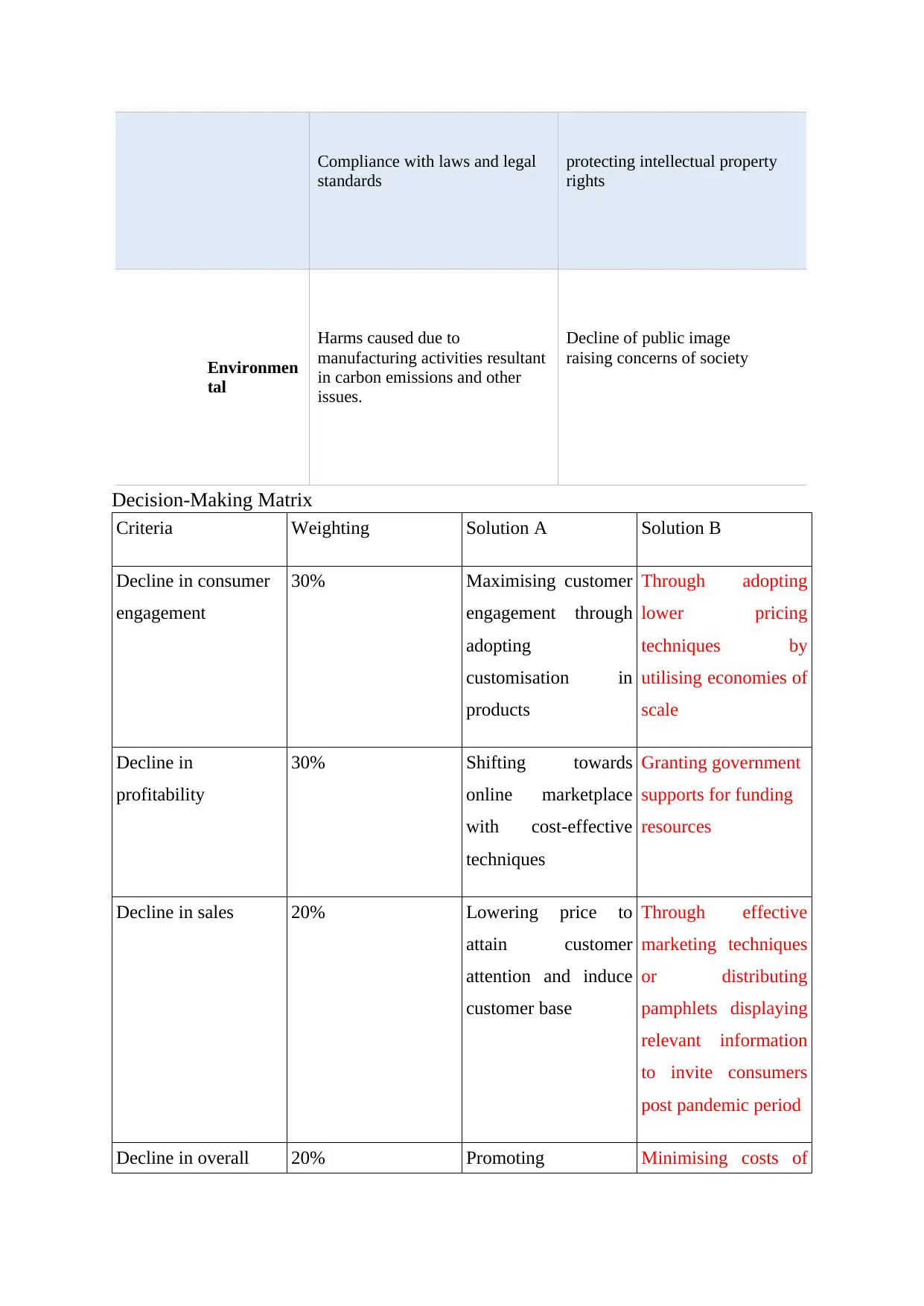
Compliance with laws and legal
standards
protecting intellectual property
rights
Environmen
tal
Harms caused due to
manufacturing activities resultant
in carbon emissions and other
issues.
Decline of public image
raising concerns of society
Decision-Making Matrix
Criteria Weighting Solution A Solution B
Decline in consumer
engagement
30% Maximising customer
engagement through
adopting
customisation in
products
Through adopting
lower pricing
techniques by
utilising economies of
scale
Decline in
profitability
30% Shifting towards
online marketplace
with cost-effective
techniques
Granting government
supports for funding
resources
Decline in sales 20% Lowering price to
attain customer
attention and induce
customer base
Through effective
marketing techniques
or distributing
pamphlets displaying
relevant information
to invite consumers
post pandemic period
Decline in overall 20% Promoting Minimising costs of
standards
protecting intellectual property
rights
Environmen
tal
Harms caused due to
manufacturing activities resultant
in carbon emissions and other
issues.
Decline of public image
raising concerns of society
Decision-Making Matrix
Criteria Weighting Solution A Solution B
Decline in consumer
engagement
30% Maximising customer
engagement through
adopting
customisation in
products
Through adopting
lower pricing
techniques by
utilising economies of
scale
Decline in
profitability
30% Shifting towards
online marketplace
with cost-effective
techniques
Granting government
supports for funding
resources
Decline in sales 20% Lowering price to
attain customer
attention and induce
customer base
Through effective
marketing techniques
or distributing
pamphlets displaying
relevant information
to invite consumers
post pandemic period
Decline in overall 20% Promoting Minimising costs of
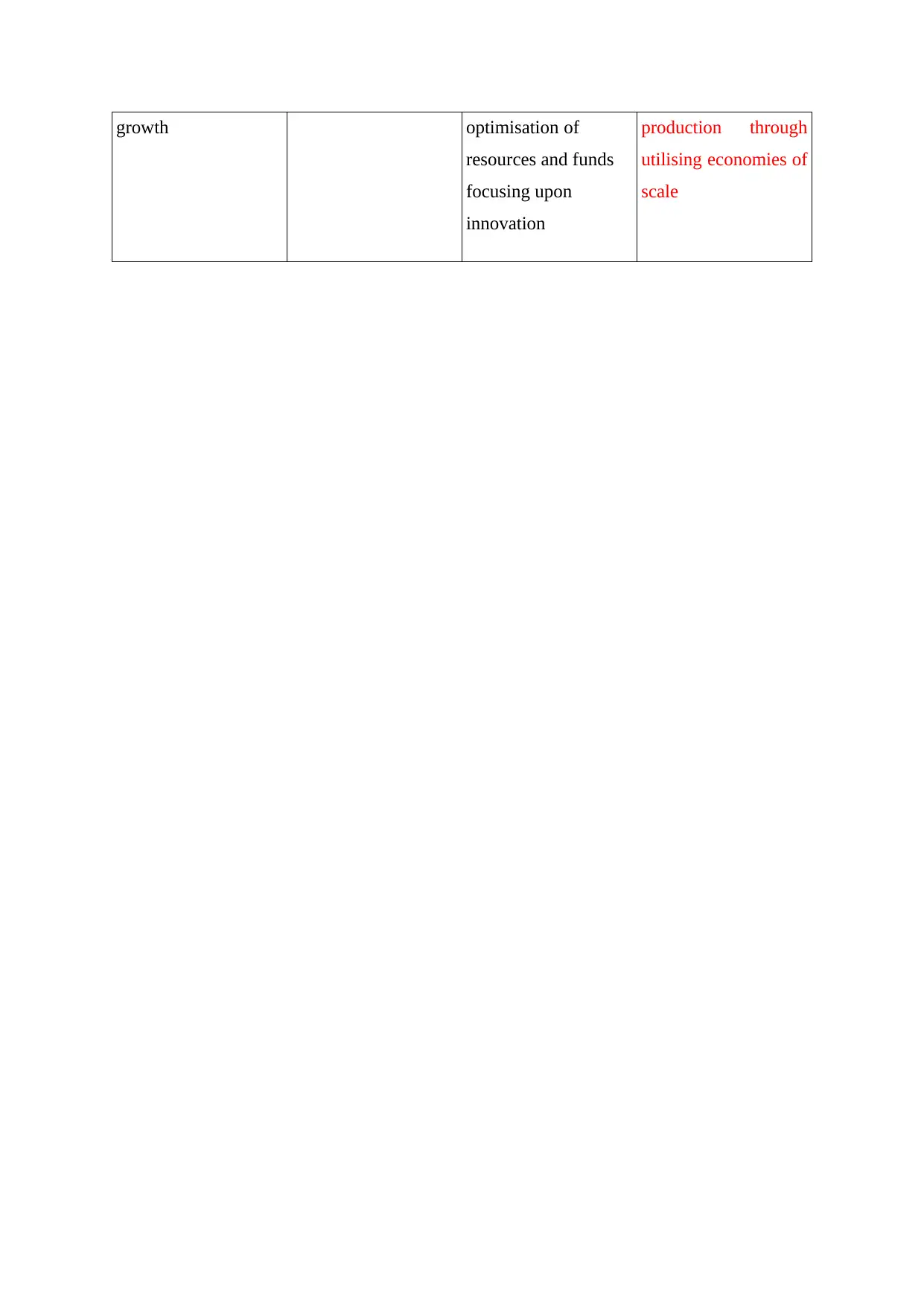
growth optimisation of
resources and funds
focusing upon
innovation
production through
utilising economies of
scale
resources and funds
focusing upon
innovation
production through
utilising economies of
scale
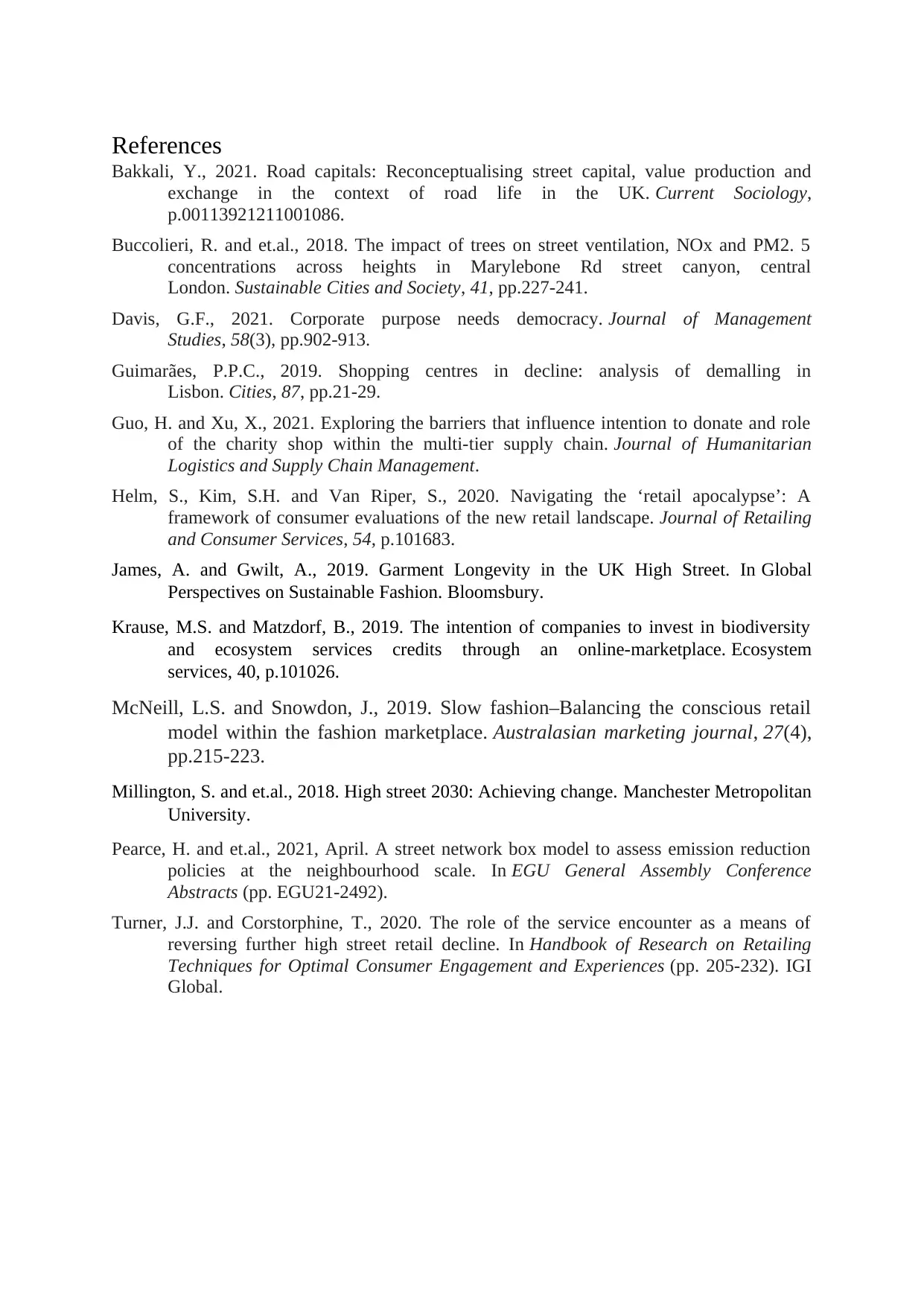
References
Bakkali, Y., 2021. Road capitals: Reconceptualising street capital, value production and
exchange in the context of road life in the UK. Current Sociology,
p.00113921211001086.
Buccolieri, R. and et.al., 2018. The impact of trees on street ventilation, NOx and PM2. 5
concentrations across heights in Marylebone Rd street canyon, central
London. Sustainable Cities and Society, 41, pp.227-241.
Davis, G.F., 2021. Corporate purpose needs democracy. Journal of Management
Studies, 58(3), pp.902-913.
Guimarães, P.P.C., 2019. Shopping centres in decline: analysis of demalling in
Lisbon. Cities, 87, pp.21-29.
Guo, H. and Xu, X., 2021. Exploring the barriers that influence intention to donate and role
of the charity shop within the multi-tier supply chain. Journal of Humanitarian
Logistics and Supply Chain Management.
Helm, S., Kim, S.H. and Van Riper, S., 2020. Navigating the ‘retail apocalypse’: A
framework of consumer evaluations of the new retail landscape. Journal of Retailing
and Consumer Services, 54, p.101683.
James, A. and Gwilt, A., 2019. Garment Longevity in the UK High Street. In Global
Perspectives on Sustainable Fashion. Bloomsbury.
Krause, M.S. and Matzdorf, B., 2019. The intention of companies to invest in biodiversity
and ecosystem services credits through an online-marketplace. Ecosystem
services, 40, p.101026.
McNeill, L.S. and Snowdon, J., 2019. Slow fashion–Balancing the conscious retail
model within the fashion marketplace. Australasian marketing journal, 27(4),
pp.215-223.
Millington, S. and et.al., 2018. High street 2030: Achieving change. Manchester Metropolitan
University.
Pearce, H. and et.al., 2021, April. A street network box model to assess emission reduction
policies at the neighbourhood scale. In EGU General Assembly Conference
Abstracts (pp. EGU21-2492).
Turner, J.J. and Corstorphine, T., 2020. The role of the service encounter as a means of
reversing further high street retail decline. In Handbook of Research on Retailing
Techniques for Optimal Consumer Engagement and Experiences (pp. 205-232). IGI
Global.
Bakkali, Y., 2021. Road capitals: Reconceptualising street capital, value production and
exchange in the context of road life in the UK. Current Sociology,
p.00113921211001086.
Buccolieri, R. and et.al., 2018. The impact of trees on street ventilation, NOx and PM2. 5
concentrations across heights in Marylebone Rd street canyon, central
London. Sustainable Cities and Society, 41, pp.227-241.
Davis, G.F., 2021. Corporate purpose needs democracy. Journal of Management
Studies, 58(3), pp.902-913.
Guimarães, P.P.C., 2019. Shopping centres in decline: analysis of demalling in
Lisbon. Cities, 87, pp.21-29.
Guo, H. and Xu, X., 2021. Exploring the barriers that influence intention to donate and role
of the charity shop within the multi-tier supply chain. Journal of Humanitarian
Logistics and Supply Chain Management.
Helm, S., Kim, S.H. and Van Riper, S., 2020. Navigating the ‘retail apocalypse’: A
framework of consumer evaluations of the new retail landscape. Journal of Retailing
and Consumer Services, 54, p.101683.
James, A. and Gwilt, A., 2019. Garment Longevity in the UK High Street. In Global
Perspectives on Sustainable Fashion. Bloomsbury.
Krause, M.S. and Matzdorf, B., 2019. The intention of companies to invest in biodiversity
and ecosystem services credits through an online-marketplace. Ecosystem
services, 40, p.101026.
McNeill, L.S. and Snowdon, J., 2019. Slow fashion–Balancing the conscious retail
model within the fashion marketplace. Australasian marketing journal, 27(4),
pp.215-223.
Millington, S. and et.al., 2018. High street 2030: Achieving change. Manchester Metropolitan
University.
Pearce, H. and et.al., 2021, April. A street network box model to assess emission reduction
policies at the neighbourhood scale. In EGU General Assembly Conference
Abstracts (pp. EGU21-2492).
Turner, J.J. and Corstorphine, T., 2020. The role of the service encounter as a means of
reversing further high street retail decline. In Handbook of Research on Retailing
Techniques for Optimal Consumer Engagement and Experiences (pp. 205-232). IGI
Global.
1 out of 13
Related Documents
Your All-in-One AI-Powered Toolkit for Academic Success.
+13062052269
info@desklib.com
Available 24*7 on WhatsApp / Email
![[object Object]](/_next/static/media/star-bottom.7253800d.svg)
Unlock your academic potential
© 2024 | Zucol Services PVT LTD | All rights reserved.





